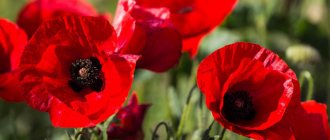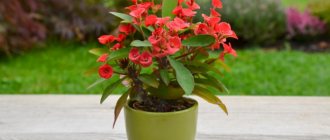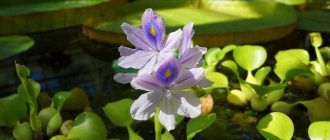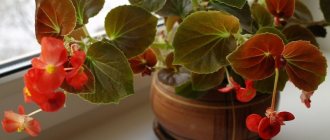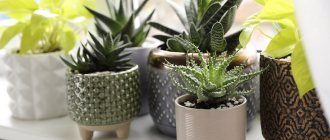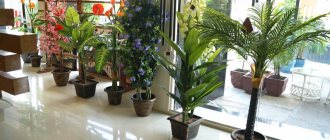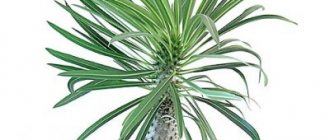Origin and appearance of clivia
Clivia belongs to the perennials from the Amaryllis family. The plant is herbaceous, numbering 5 species in the genus. Homeland - South Africa, habitat - tropical forests, shady foothills and coasts.
Clivia's habitat is tropical forests
Clivia became famous in the 19th century, and it was named after the Duchess of Northumberland, Charlotte Clive.
Clivia reaches a height of 60 cm and has no stem. The leaves are leathery and broadly belt-shaped, growing from the root. They tightly embrace each other, creating something like a stem. The flowers, in their shape, resemble a bell or a gramophone, are collected in a thick, multi-flowered umbrella, numbering up to 60 flowers. Colored in yellow-pink, orange and red-orange. The rhizome is short, with fleshy, slightly fibrous roots. Serves to accumulate moisture and nutrients.
Clivia is self-pollinating. The process of ripening fruits and seeds lasts up to 10 months and takes a lot of energy from the plant.
Clivia seeds ripen within 10 months
Clivia is a long-lived flower. With proper care, this beauty can live up to 40 years.
How is clivia different from valotta?
Valotta looks similar to clivia
These two plants are similar - it is very difficult to distinguish them. But if you look closely, you will immediately find characteristic features:
- The root of valotta is a bulb, while that of clivia is a rhizome.
- The leaves are different. In Valotta they are narrower, reddening at the base, growing not from the rhizome, but singly, filling the pot.
- The inflorescence of Valotta is not as multi-flowered as that of Clivia. But the flowers themselves are larger.
- Valotta produces numerous babies, which often grow on the surface of the soil.
- If you accidentally damage a clivia leaf, bright orange juice will appear on it.
Fans of indoor floriculture love clivia for its unpretentiousness and beauty. The plant can easily be used both as an ornamental foliage plant and as a flowering one. And even the most inexperienced gardeners can handle the new varieties that have appeared and are suitable for growing in an ordinary apartment.
Flower growers fell in love with clivia for its beauty and unpretentiousness.
Types and varieties of clivia
As already mentioned, there are five types of clivia:
- Clivia Gardena. Named after Major Robert Garden, who discovered this species. The plant grows up to 50 cm in height. The leaf shape is xiphoid, up to 50 cm long and 4 cm wide. The leaf blades are painted bright green. The peduncle is up to 45 cm, it contains about 16 flowers, which have a narrow tubular shape and are colored in shades of red and orange.
- Clivia stem. The only species in which a trunk up to two meters high is formed from dried lower leaves. The leaves reach a length of up to 100 cm, are dark green in color and have a belt-like shape. Sometimes it produces several flower stalks. Each can have up to 20 drooping, bell-shaped, orange-red flowers. The tips of the petals are painted soft green.
- Clivia is wonderful. Miniature appearance, only up to 30 cm in height. The leaves are sword-shaped with a sharp edge, dark green. The long peduncle can contain up to 60 tubular-shaped flowers. The color is orange with a bright yellow center.
- Clivia cinnabar, or orange (miniata). Herbaceous perennial with dark green, belt-shaped leaf blades. Their length is 60 cm and width is 6 cm. The leaves are collected in a rosette. The plant reaches 50 cm in height. The length of the peduncle is 45–50 cm. The umbellate inflorescence contains about 20 flowers, shaped like a wide funnel and colored yellow-orange, sometimes with a yellow spot at the base. Once fully opened, they form a stunningly beautiful flower ball.
- Clivia is amazing. This plant really amazed and surprised botanists, since the climatic conditions of its habitat are sharply different from those in which other types of clivia grow. The view was opened only recently, but is already popular.
Types of clivia in the photo
Clivia is amazing
Clivia Gardena
Clivia is beautiful
Clivia stem
Clivia cinnabar
In addition, there are many varieties and varieties of this stunning flower.
Variety of clivia varieties - photo gallery
The Midas variety has lemon-yellow flowers.
Variety cyrtanthiflora “Porcelain” – a hybrid of clivia vernacular and noble clivia
Mark's Pink variety has orange flowers
Summer Surprise flowers have a delicate salmon hue
Sir John Thuron Yellow – large-flowered variety, yellow color
The Japanese pastels variety is painted in calm and soft pastel colors
It should be remembered that clivia is a poisonous plant; it contains the alkaloid lycorine. It can cause not only indigestion, but also nausea and vomiting. Large doses can lead to paralysis. In families with small children or pets, clivia must be placed in places inaccessible to them.
Clivia is a very beautiful plant, but you should remember that it is poisonous
Clivia
(Clivia nobilis - noble clivia or Clivia miniata - matte red clivia, red lead).
Clivia comes from Port Natal, west coast of South Africa. On the map this place is colored green and is separated from the Karoo Desert by the Drakensberg Mountains. Here there are lowlands, more humid conditions, and there is no need to “hide” from the drought.
But there are plants that provide themselves with moisture reserves accumulated in the roots during drought.
On the windows you can see pots hanging on strings. From such a pot hang vines up to one and a half meters long, on which there are bunches of narrow linear leaves. At the bottom of the bunches there are noticeable thick roots. Sometimes this plant produces thin and long flower shoots with small white star-shaped flowers.
Rice. Chlorophytum with layering
Conditions for seasonal maintenance of clivia - table
| Season | Temperature | Humidity | Lighting | Location |
| Spring | During the growing season, keep the temperature within +20...+26 °C. At +28 °C the leaves may dry out and growth slows down. | Clivia does not need high humidity. It is enough to maintain a level of 45–50%. On very hot days, you need to wipe the foliage with a damp cloth, removing dust, and sometimes spray it. | For clivia, bright but diffused light is preferred. It is better to hide it from the sun's rays behind a light curtain. Do not place clivia in a darkened room - this will negatively affect flowering. | It is ideal to place clivia on a western or eastern window, shading from 11 a.m. to 5 p.m. During the summer months, you can move the plant to the balcony or garden, finding a place protected from drafts and bright sunlight. |
| Summer | ||||
| Autumn | The optimal temperature for this period is from +10 °C to +15 °C. | From the end of autumn, move the pot with the plant to a south window, shading it from the midday sun. | ||
| Winter |
Clivia will do well outdoors during the summer months.
The room in which clivia grows should be ventilated periodically. On a north window, due to lack of light, it will be difficult to achieve clivia flowering. On a south window in the summer, the leaves of the plant will suffer from burns.
Bulbous primroses at home
Daffodils, freesias and hyacinths that bloom in early spring in the garden can be grown at home.
Hyacinth
There are no leaves on its large peduncle, but a huge number of small flowers bloom. They can be white, pink, blue, greenish, scarlet and purple. The flowers, sitting very tightly, form an incredibly beautiful hat. Each bulb produces only one stem, which blooms for two or three weeks.
Freesia
Freesia reaches a length of 30-45 cm. On one side there are delicate funnel-shaped flowers of orange, red, yellow, pink, burgundy or white. All its varieties are very fragrant.
Daffodils
Plants up to 20 cm tall with squat linear leaves and leafless stems. One inflorescence can produce from two to ten flowers of various sizes and colors. The perianths consist of six reflexed lobes and cylindrical tubes. Daffodils come in many varieties, including:
- Tubular daffodils with yellow, white and bicolor flowers.
- Large-crowned daffodils, which have many varieties with flowers of pure yellow and white, as well as flowers with an orange crown.
- Small-crowned daffodils are distinguished by two-color petals and yellow or white perianth.
- Double daffodils are flowers with six perianth lobes. Their flowers can be yellow, white or bicolor.
What you need to know about planting and transplanting
When preparing to plant clivia, take care when choosing a pot. It should be high and deep, with drainage holes. This is due to the fact that the plant has powerful roots growing deep into the soil. It is better to buy a ceramic pot, it is more stable, slightly larger in size than the previous one - the difference should be literally a couple of centimeters. In a cramped pot, clivia feels much more comfortable and blooms more readily.
A tall pot is suitable for planting clivia.
The soil is suitable: loose, light, well-permeable to moisture and air, slightly acidic - with a pH of about 6. Most often, gardeners use this mixture for planting:
- Turf soil - 2 parts.
- Leaf humus - 1 part.
- Peat - 1 part.
- Perlite or coarse sand can be added as a leavening agent, and charcoal acts as an antiseptic.
Only young clivias are replanted annually. It is better not to touch adult plants for 2–3 years. They need to be replanted only if the roots have grown through the drainage hole or the plant is sick.
Only young plants should be replanted annually
The transplantation process begins only after the clivia blooms.
Step by step process
- Pour a layer of drainage into the new pot so that it completely covers the bottom. Then add soil substrate.
- Carefully release the plant from the old pot. There is no need to forcefully shake off the soil. Your task is not to harm the fragile roots. Injured roots can cause the death of the plant. Immediately sprinkle the damage with crushed coal or ash.
- Transfer the clivia into the prepared pot, adding the remaining wet soil to the sides.
- Try not to bury the root collar.
- After transplantation, do not water the clivia for several days; you can only lightly spray the top layer of the substrate. The wounds on the roots will heal during this time.
- Then continue the watering process as usual.
Clivia is transplanted using the transshipment method
After replanting, try to place the plant exactly as it was before. You should not turn the clivia every now and then with different sides to the light source.
Sun-loving, beautifully flowering indoor plants
To choose a place for indoor plants, it is sometimes useful to know where their homeland was. And if the flower came from the equatorial zone, but grew under the cover of the jungle, then it will easily tolerate shading. But if the plant’s homeland was an open sunny space, then without a daily dose of sunlight, success will not be achieved.
Let's look at the photo and learn more about some indoor plants that are lovers of sunbathing.
Primrose (lat. primula)
A perennial flowering plant with evergreen leaves up to 15 cm long. The foliage is corrugated and forms a rosette.
Bright primroses
The inflorescences are collected in umbrellas or solitary, the corollas are double or simple. There are varieties that combine a silvery coating on the petals and two-color petals or a bright core. There may be no smell.
In order for the flowering to be bright and long, it is better to choose the lightest place and water it in such a way that the soil is always moist. The leaves themselves cannot be watered.
It is better to place the pot on wet gravel. Primrose loves geranium soil and fertilizers.
Fuchsia (lat. fuchsia)
They are evergreen or deciduous, erect or may have drooping stems.
The flowers resemble small, up to 8 cm, lanterns and are pleasing to the eye from mid-May until the first frost. Color range: white, pink, red, pink-lilac, purple, combining two colors. The leaves are oval, matte, located opposite on red stems. The edges of the leaves are serrated.
Magic fuchsias
The plant loves a certain amount of direct sunlight, so you need to place the pot where the sun shines in the first or second half of the day.
Watering depends on the air temperature, but the substrate should dry out between waterings. The plant is sprayed twice a week. Replanting is needed annually, and young plants need to be replanted several times a season into enriched garden soil with sand.
In summer, fuchsias are usually taken outside into some shade.
Persian cyclamen (lat. cyclamen persicum)
Herbaceous tuberous plant with a long flowering period. The flowers are admired during the cold season: the magical bent flowers of white, pink, and red tones begin to bloom, usually in November, and end in March-April. The leaves are heart-shaped and dark green in color with a beautiful whitish-silver pattern.
Cyclamen blooms very vigorouslyCyclamen
Cyclamen loves direct sunlight while flowering.
Replant in the fall in deciduous humus with sand and peat.
It is difficult to make cyclamen bloom again in an apartment, however, with the help of annual replanting and regular fertilizing, the plant continues its life cycle.
Plant care
Watering
The plant needs to be watered well, but not often. The rule is that it is better to underfill than to overfill; this is perfect for a flower. The next watering is carried out when the top layer of soil dries out - approximately once every 4-5 days. Make sure that the root collar does not get wet. Always drain the moisture from the pan. Water with warm, settled water.
Clivia root is able to accumulate moisture - this helps the plant easily tolerate drought.
With the onset of autumn, when the temperature begins to drop, the amount of watering is reduced. This helps the plant prepare for the dormant period. In winter they stop watering. But there are exceptions - if the clivia begins to shed its leaves, then it can be slightly moistened.
Top dressing
The ideal fertilizing option would be to alternate mineral fertilizers with organic ones. Nitrogen included in fertilizing has a positive effect on the growth of leaf mass, but reduces the flowering period. The frequency of feeding is 2 times a month.
For fertilizing, you need to choose fertilizers for flowering or bulbous plants, diluting them a little more than indicated on the package. Apply fertilizer only in liquid form after watering.
In winter, clivia is not fertilized.
Clivia is responsive to the application of fertilizers, but you should not abuse them
Rest period
This period is very important for the formation of a flower bud and further flowering. In young plants, the dormant period is shorter and lasts about two months, while adult plants will need more time to regain strength - at least 3 months. This important stage begins in October. Reducing the frequency of watering helps the plant smoothly transition to rest. During dormancy, fertilizing and watering stop; you can only occasionally moisten the surface of the earth with a spray bottle so that the leaves do not begin to dry out. The temperature in the room with clivia should be maintained at +10 °C…+12 °C.
Keeping clivia in a cold room for too long can slow down the growth of the peduncle. In this case, water the flower with water heated to +40 °C. This will help the plant come out of dormancy and stimulate the peduncle, causing it to develop normally.
Young plants that have not reached the age of three years are not sent to rest.
The rest period for clivia is the key to rapid flowering
Bloom
As a rule, clivia blooms in February, after the end of the dormant period. The buds open gradually, so you can admire the beautiful sight for almost a month.
As soon as a peduncle appears, the length of which will be at least 10–15 cm, move the clivia to a warm room. Start fertilizing and watering. The main thing is not to overdo it, the whole process follows the usual pattern.
An adult clivia can delight you with repeated flowering in the summer. In order to admire the wonderful flowers, create an artificial dormancy period for the plant in mid-summer. Move the pot to a cool, slightly dark place. Reduce watering and stop fertilizing altogether. After about 2 weeks, the lower leaves of the clivia will begin to turn yellow, but at the same time a new peduncle will appear.
After the peduncle fades, do not rush to remove it immediately. Let it dry completely, and then carefully unscrew it from the sheet socket. But if you decide to wait until the fruits and seeds ripen, leave the peduncle, water and fertilize the plant regularly. There will be no repeat flowering this year.
An adult clivia can delight you with flowering 2 times a year.
Errors in care and their elimination - table
| Problem | Cause | Elimination |
| Clivia doesn't want to bloom |
|
|
| The peduncle is too short during the active growing season |
|
|
| Leaves lose color, flower stalks do not form | Lack of nutrients. | Adjust plant nutrition. |
| Light spots appear on the leaves | Sunburn. This problem is relevant for a plant standing on a south window. | Shade the plant. |
| The tips of the leaves become brown, the base of the stem and roots rot | Overmoistening of the soil. |
|
| During the growth period, the leaves began to turn yellow and die. |
|
|
Underdevelopment of the clivia peduncle is possible due to prolonged exposure to low temperatures on the plant.
Diseases and pests, control measures and prevention - table
| Diseases and pests | Symptoms | Control measures | Prevention |
| Stagonosporosis, or red burn | Red spots appear on the leaves and peduncles, and the damaged parts become soft. With severe damage, the leaves are deformed, the flower stalks are bent, and the intensity of flowering decreases. |
|
|
| Shchitovka | The plant is covered with brown tubercles. Young pests very quickly spread throughout the plant, feeding on its sap, weakening the clivia. | Treatment is carried out with the help of Actellik. The solution should be prepared strictly according to the standards indicated on the label. Processing should be carried out outdoors, using protective equipment - gauze bandage, gloves. |
|
| Mealybug | The leaves become deformed, dry out and fall off. White discharge, similar to pieces of cotton wool, appears on the affected parts of the clivia. Severely damaged flowers seem to be covered with fluff. | ||
| Aphid | The pest settles on the underside of the leaf. It feeds on the sap of the plant, injects poison into it, which greatly depletes the flower, making it defenseless against fungal diseases. |
Threats to clivia in the photo
Aphids significantly weaken clivia
Plants heavily infested with mealybugs appear to be covered in fluff.
Scale insect larvae can spread throughout the plant very quickly
The appearance of stagonosporosis is promoted by constant waterlogging of the soil.
Pests and diseases
Clivia rarely suffers from any diseases or pests, but if this happens, it is most often due to shield aphids, rot or mealybugs.
- If a plant suffers from shield aphids, this can be easily noticed by growths and dark spots on the leaves. Adult aphids are covered with a protective layer and practically do not move, so they do not pose any particular danger, but the larvae can disperse throughout the plant. To get rid of this pest, it is enough to wash the plant with a soap solution with the addition of kerosene. An adult plant can be wiped with a swab.
- If there is a white coating similar to cotton wool on the leaves of a plant, this means that it has been “attacked” by a mealybug, which can be removed by wiping with a damp swab. If there are a lot of pests, then you need to spray the clivia with an insecticide every week until it becomes healthy again.
- If the clivia leaves begin to turn yellow, i.e. die off, then the reason lies in the damaged roots that were affected during transplantation. To prevent rot, you need to get rid of these roots and sprinkle the cut areas with crushed coal, and if possible, replant them in new soil with special care.
- If clivia does not bloom, this means that before the flowering period conditions were not created for its comfortable wintering: temperatures above 15 degrees, insufficient lighting or even frequent watering, feeding. In this case, the plant may bloom, but the flowers will be sluggish and in small quantities. To make clivia bloom, you will have to wait for the next dormant period to provide all the conditions for it and further flowering.
Reproduction
At home, clivia is easily propagated in two ways: vegetatively - by division during transplantation, and generatively - by germinated seeds.
Division
Division is the easiest and most popular way to propagate clivia. But it should be carried out only during a planned transplant after flowering, since the plant really does not like interference. For separation, lateral shoots that have grown at least 10 cm from the soil surface and have 4 leaves are suitable.
- Prepare small pots, 7 cm in diameter, and fill them halfway with sand or a mixture of sand and leaf soil.
- Carefully separate the babies from the mother plant, being careful not to damage the roots. If this happens, immediately sprinkle the wounds with activated carbon.
- Place the separated plants in pots and add sand mixture.
- Lightly moisten the soil and place the clivia in a bright place with a temperature of +18 °C.
- After rooting, the young plants are transplanted into slightly larger pots with a suitable earthen mixture. Clivias will bloom in 2–3 years.
Dividing clivia during transplantation is an easy way to propagate the plant.
Planting seeds
This method is not as popular as the first. Seeds can be bought in a store or collected yourself by artificially pollinating a flowering clivia. In this case, you need to wait until the fruits are fully ripened. When they are completely soft, it is time to collect the seeds. The right time to germinate them is from October to April.
The seeds are laid out on a substrate consisting of equal parts sand and turf soil, half part peat. The distance between the seeds should be approximately 2 cm. The container is covered with a cellophane bag, creating greenhouse conditions. The humidity inside should be sufficient, but not excessive. Temperature about +25 °C.
The distance between clivia seeds when planting should be at least two centimeters
Expect seedlings to appear in about 5 weeks. Seedlings can be planted as soon as they have one leaf.
A clivia seedling, ready to be transplanted into a separate pot, looks like this
The most popular houseplants of the bulbous group
Bulbous flowers are grown for cutting to create flower baskets, bouquets and spring arrangements. Many of them grow quite successfully indoors.
Hippeastrum
It is often (and incorrectly) called amaryllis. Its homeland is South America. Mostly hybrids with flowers much more beautiful than those of the original species grow in the rooms. The leaves of the hybrid hippeastrum are long, linear, the bulb is large, funnel-shaped flowers sit in 2-6 pieces on the crown of a tall and thick peduncle. Depending on the variety, they can be from pale pink to dark red, sometimes variegated, with streaks and specks. Large bulbs form two arrows.
The plant is light-loving, it needs to be given sunny places; it grows well in rooms on windows facing south, southeast, southwest. For hippeastrum to bloom, a period of deep dormancy is required. By adjusting its timing and duration, you can have flowering plants all year round.
During the rest period, I put the pot with hippeastrum in a dark place, water it rarely and little by little, just so that the soil does not dry out.
Its flowers, like those of other bulbous plants, open at different times. But there are several of them on the arrow, and therefore, in general, flowering lasts 2-3 weeks. The pot you need is not very large (the distance from the edge of the bulb to the edge of the pot should be 1.5-3 cm). In a container that is too spacious, the plant will become fatty and may not bloom for a long time.
Krinum
R
also from South America. Its leaves are long, linear, bright green. The large bulb is covered with thin light gray protective films. Fragrant white and pink flowers are collected in 6-10 pieces. Krinum usually blooms in spring or summer. Large bulbs sometimes have 2 flowers open at the same time.
Krinum needs a bright, sunny place, and the pot for it should be large. I replant old plants once every 2-3 years, and one third of the bulb should be visible from the ground.
Eucharis
Eucharis, or Amazon lily, is a very beautiful bulbous plant with beautiful white fragrant flowers. Its leaves are wide, dark, shiny, on long petioles.
Eucharis blooms once, sometimes twice a year - in autumn and spring, winter, during the dormant period, requires moderate watering (but more abundantly than hippeastrum). The plant is light-loving. He needs a small, low and wide pot. It refuses to bloom in a spacious room until numerous bulbs fill it and they become crowded. Therefore, it should be replanted no more than once every 4 years, and the bulbs should be completely buried.
Pankratsiy
Its white, fragrant flowers look like antique lace due to their narrow, thin “petals.” Flowering time is autumn or early winter. Pankratium blooms best on south-eastern windows. Watering is moderate during flowering and rather scarce during the dormant period. Plants should be replanted in the spring once every 2-3 years. The bulb is sunk into the ground only one third, the baby is separated for reproduction.
Clivia
Clivia, or Kaffir lily, as the name indicates, came to us from South Africa. This plant is remarkable for its unpretentiousness. Clivia leaves are long, dense, dark green.
The flowers are orange-red, collected in a bunch at the top of the peduncle. There can be up to 40 of them on one arrow; on old plants there are up to 5-6 arrows at the same time. Old specimens may bloom again in winter. Clivia is propagated by seeds and daughter bulbs.
Tall indoor plants
Hybrid canna is a colorful, eye-catching, fairly large plant up to one meter in height. Each stem produces large flowers that can be purple, red, yellow, cream, orange or pink. Canna's oblong leaves can be light green, dark green, bronze-red, purple-tinged brown, or striped. With age, three or four shoots may appear from one corm.
Hippeastrum has a rather large bulb, the diameter of which can reach 11 cm. From one to six large funnel-shaped flowers are formed on each stem. Flowering most often occurs in spring and winter, but can sometimes bloom in summer. The most common types of hyperastrum include:
- Hippeastrum striped is distinguished by a median keel with red-lilac stripes and elongated ovoid white petals, between the edges of which there is a longitudinal stripe.
- Hippeastrum graceful is a plant whose height can be from 45 to 70 cm. Large funnel-shaped greenish-white or whitish-yellow flowers are formed in January and in May or June.
- Hippeastrum reticulum is a stem 30-50 cm high. Lanceolate leaves and a peduncle with 3-5 buds sprout from a small bulb. The crimson-red petals have numerous dark veins.
- Hippeastrum reginas is distinguished by linear-lanceolate leaves and perianth with a red funnel-shaped tube and a whitish-green pattern in the throat.
- Hippeastrum Leopolda is a plant with a strong, two-flowered stem. Flowers up to 18 cm in diameter are white at the top and red in the middle.
Amaryllis is very similar to hippeatum, but has an incomplete peduncle, blooms only once a year in the fall and regularly produces daughter bulbs. Amaryllis grow up to 50-70 cm in height. Each stem produces 8–12 large pink-red flowers. Three or four plants can be planted in one pot at once. With proper care, a flower can exist for many years.
Wallota belongs to the amaryllis family. It has reddish, dark green, linear leaves at the base. The length of each leaf reaches 65 cm and the width is 3.5 cm. An umbrella with flowers of salmon, white or bright red color is formed on a long stem. After it fades, there is no need to immediately pick off the flowers. You should wait until the flower stalks dry and then trim them.
Eucharis (see photo) can also be classified as a tall flower. The second name is Amazonian lily. This beautiful plant resembles a daffodil. Its snow-white, fragrant, umbrella-shaped flowers appear in October and bloom until winter. Eucharis then goes dormant in March and blooms again in the spring. On one long stem of eucharis, 50 cm high, three flowers are formed at once.
Which to choose?
When purchasing a large indoor plant, you need to take into account several factors, and the first of them is the difficulty of care.
It is important to assess how hardy the plant is to its living conditions, find out the requirements for soil, lighting, indoor humidity levels, the need for pruning and frequent watering. Think about your willingness to spend a lot of time and effort caring for such a pet.
Consider your willingness to invest a lot of time and effort into caring for such a pet.
Find out in advance how quickly the plant you like grows, because many are not ready to wait several years or even decades before it reaches impressive dimensions. If you need results in the coming months, then it makes sense to purchase fast-growing varieties or an already mature plant.
If you plan to grow two or more crops, then consider their compatibility.
Some people prefer fuchsia, some like palm trees, while others like classic hibiscus or unusual cypress trees. Personal preference should be the deciding factor when choosing a green pet.
How to water and fertilize?
Any home crop needs sufficient moisture. When watering, you must follow certain rules:
It is important to moisten the soil in a timely manner. Most indoor plants like the soil to be constantly moist; the amount of liquid is increased during the period of active growth and flowering. Typically this occurs in spring and summer; on especially hot days, the plant must not only be watered, but also its above-ground parts must be irrigated
It is best to use a spray bottle for these purposes; water for irrigation should be at room temperature (for exotic plants native to hot countries, you can warm it up a little); some species do not like direct contact of liquid with the roots, so they should be watered very carefully.
Carefully! Excess moisture is just as detrimental to a plant as its lack, so you should not over-moisten the soil. Otherwise, there is a risk of soil acidification, rotting of the root system, and fungus developing.
Feeding and fertilizing are usually carried out during the growing season, in the spring. In some cases, additional fertilizer is required, for example, if unsuitable soil is used for growing. This procedure is best carried out in early autumn.
Sources
- https://lafoy.ru/komnatnye-cvety-foto-i-nazvaniya-katalog-656
- https://moyasotka.com/tsvety/komnatnye
- https://agronom.guru/komnatnye-cvety-s-foto-i-ih-nazvaniyami
- https://kvartblog.ru/blog/bolshie-komnatnye-rastenija/
- https://WikiBotanika.ru/polezno-znat/komnatnyie-lekarstvennyie-rasteniya.html
- https://www.flowerbank.ru/?p=6414
- https://anisima.ru/lechebnye-komnatnye-rasteniya/
- https://RoomFlower.ru/poleznoe/poleznye-komnatnye-rasteniya.html
- https://careflowers.ru/cvetovodu/komnatnye-tsvety-katalog-s-fotografiyami-i-nazvaniyami/
- https://pocvetam.ru/komnatnye-rasteniya/bolsie.html
- https://ufermer.com/komnatnye-rasteniya/samye-bolshie.html
- https://CozyBlog.ru/dekor/komnatnye-derevya.html
- https://stroy-podskazka.ru/komnatnye-cvety/bolshie/
Errors in care
Even experienced flower growers sometimes cannot avoid problems in caring for clivia. A plant considered unpretentious sometimes reacts sharply negatively to failures in watering, temperature and lighting .
It can be difficult to understand why clivia does not bloom. Let's start analyzing the errors with this pressing question.
Why doesn't clivia bloom?
Several factors may be to blame for the lack of flowering:
- Incorrectly organized rest period . If a flower rests in a warm place, it does not gain strength to bloom.
- Excess nitrogen in fertilizer . The high nitrogen content in fertilizing stimulates the growth of greenery, preventing the formation of a peduncle.
Another question is how to make clivia bloom. The answer to this is very simple: conscientiously comply with all care parameters:
- mandatory rest period;
- feeding from May to August;
- proper lighting;
- no pests.
If one of these parameters is violated, it becomes clear why clivia does not bloom and what to do in these cases.
Attention! A short peduncle in clivia indicates that the plant is cold or the air is oversaturated with moisture.
The leaves are turning yellow
The yellow color of the leaves may be due to the adaptation of the plant after transplantation . A shift in watering volumes to a lesser or greater extent also leads to yellowing of the foliage.
If there is obvious excess watering and yellowness appears on the leaves, you will have to change the soil in the pot to save the roots of the plant.
Lack of nutrition can also lead to yellowing . If the problem occurs during the rest period, discard your worries: this is a normal reaction of clivia to rest.
Leaves are drying
Drying of leaves is a consequence of excessive soil moisture . By organizing your watering schedule, you will avoid this problem. Dry or red marks on the leaf blade occur from sunburn.


